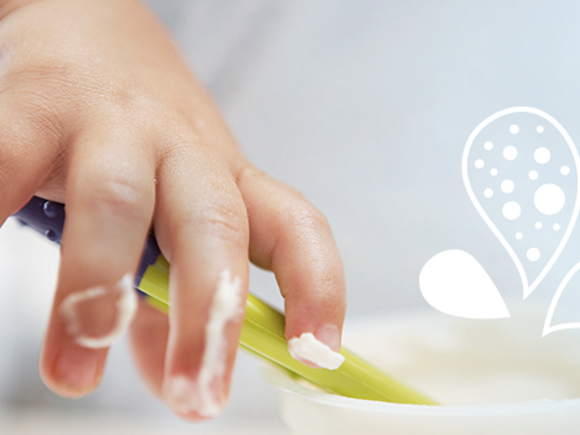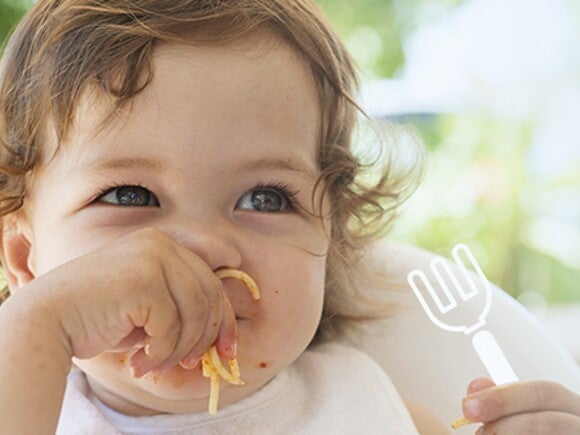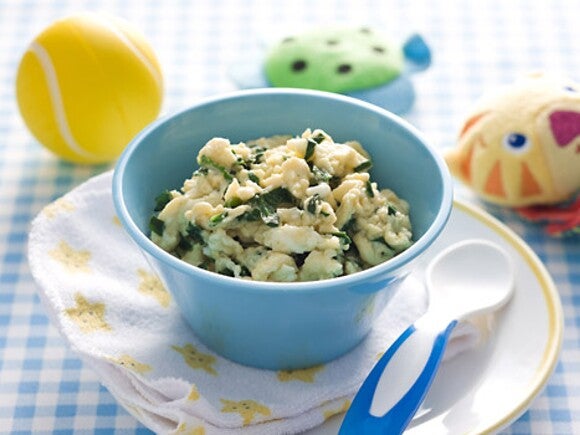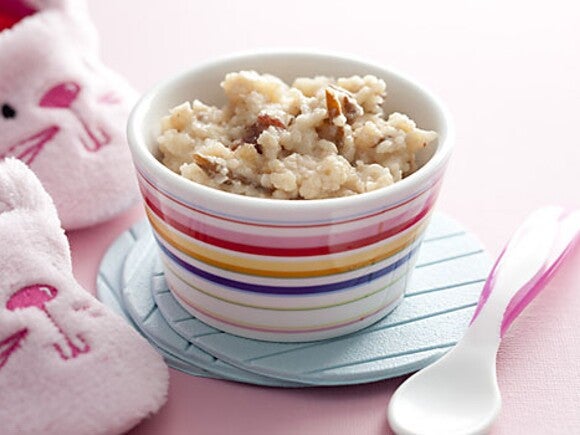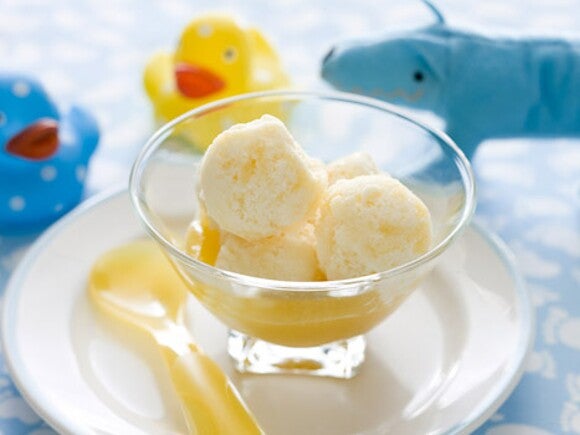Mixing up food ideas across the five food groups
Variety, balance, and multiple tries are keys to a healthy diet for your 9 to 12 month old. Offer foods from each of the five groups every day and be sure they are getting the chance to experience different textures.

1. FRUITS

Sweet-tasting and easy to mash even with few, or no, teeth, bananas are an unsurprising favourite fruit. A great nutritional choice, they are full of potassium, which helps your baby’s muscles and nerve cells work properly.
Looking to diversify your 9 month old’s diet? As your baby transitions to 10 and 12 months, give your baby some more variety by swapping bananas for rockmelon, strawberries or oranges—all potassium-packed heroes.
2. VEGETABLES
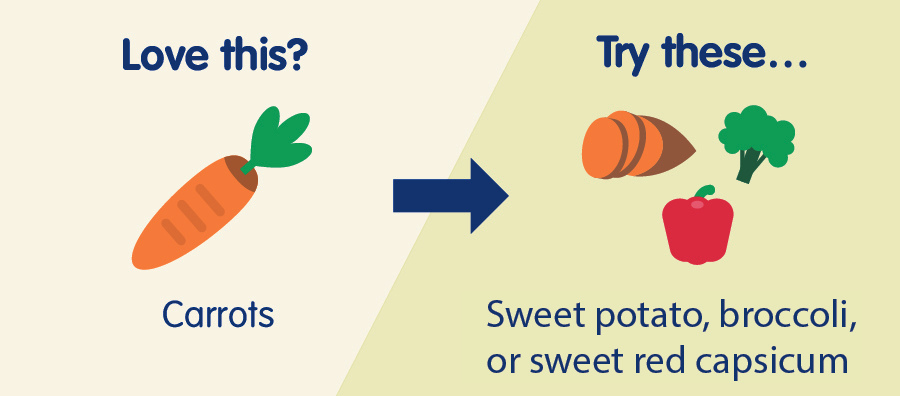
Carrots are a firm favourite for tiny tummies for their flavour and versatility of texture. You can offer your baby cooked carrots in various ways, from mashed to finger-sized pieces. They are rich in vitamin A, which is essential for your little one’s healthy eyesight.
Wanting more nutritious vegetable options for 9 to 12 month old babies? Sweet potatoes, red capsicum, or broccoli instead of carrots at mealtimes and you’ll still be giving your baby a source of essential vitamin A.
3. MEAT/FISH/PROTEIN FOODS
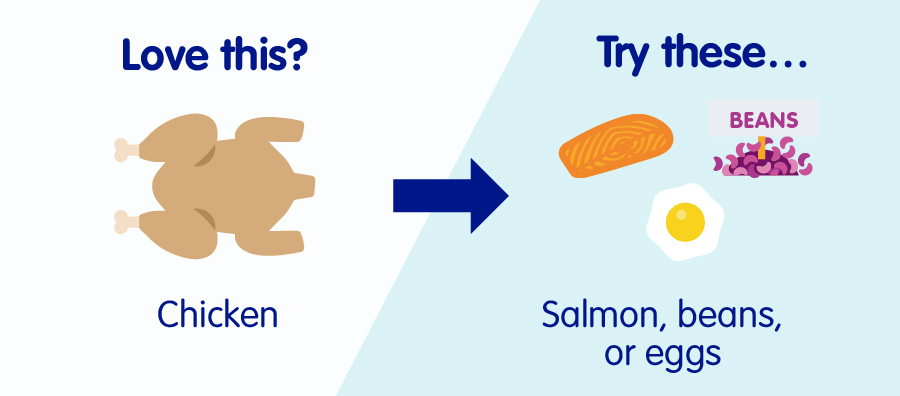
Poultry, such as chicken or turkey, is a popular food for many beginner eaters, and the rest of the family too. Easy to cook, it can be prepared in lots of different ways and served as part of a variety of meals. Poultry is a good source of protein, which is important for growth and development.
Hoping to add more protein-packed foods to your 9 to 12 month old’d diet? Next time you’re at the store, put salmon, beans, or eggs in your shopping cart instead of chicken. Beans and eggs are great non-meat sources of protein, while protein-rich salmon has the added benefit of containing omega 3 fats.
4. GRAINS
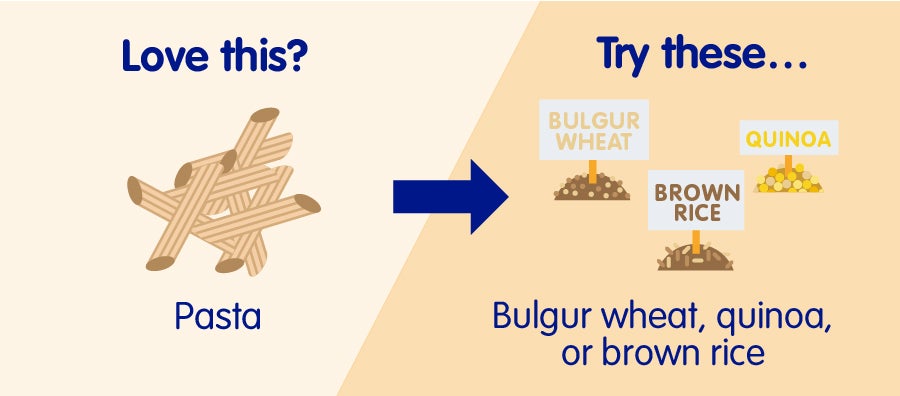
Soft to eat and easy for little fingers to grasp, pasta is a much-loved food for many babies. It’s quick to cook and can be enjoyed hot or cold, with or without sauces. Pasta is also a source of fibre (if you choose wholewheat varieties).
Ready to broaden your 9 to 12 month old’s palate with wholesome grains? Before automatically putting pasta into your pan, consider whole grains, such as bulgur wheat, quinoa, or brown rice for a bit of variety. Your baby may enjoy these slightly different textures, and they’ll still be getting fibre from them.
5. DAIRY
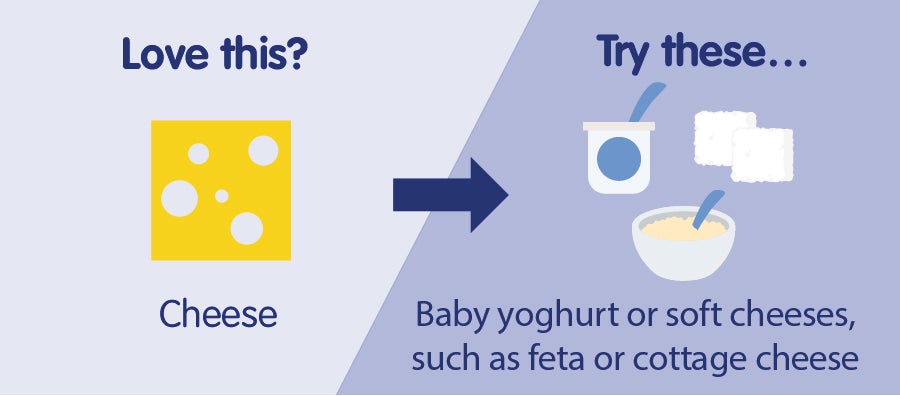
Sliced for little fingers, cheese is a staple food for many babies. It provides your little one with lots of important nutrients, including calcium, which is very important for their bones and teeth.
Seeking additional dairy options suitable for 9 month olds and beyond? Softer cheeses, such as feta or cottage cheese, are great alternatives to harder cheeses like cheddar as long as they are pasteurized. They give your baby the chance to try different textures without missing out on bone-building calcium. Baby yoghurt is another good source of calcium.
FAQs
What food can I give my 9 month old?
At 9 months old, food ideas could include soft or slightly mashed fruits and vegetables, cooked and mashed grains like rice or oatmeal, well-cooked and shredded meats, and small amounts of dairy products like yoghurt or cheese. Introduce finger foods like small pieces of soft fruits or cooked vegetables. Always ensure foods are appropriate for your 9-month-olds development, cut into small, safe pieces, and supervise your baby during meals. Consult with your healthcare professional for specific recommendations based on your baby's development and any individual dietary considerations.
What finger foods can a 9 month old eat?
Finger foods for your 9 month old can include small pieces of soft fruits or cooked vegetables. As all babies develop at different rates, choose foods that are appropriate for your child aim to include a variety of foods from different food groups. Cut soft fruits, vegetables, and cheese into small, safe pieces, and supervise your baby at all times while they eat. Try our savoury mini muffins, perfect for little fingers to hold and eat.
What food can I give my 10 month old?
At 10 months of age, your baby can enjoy a variety of foods from all the food groups. Food ideas for 10-month-olds can include soft, cooked or roughly mashed fruits, vegetables, grains like rice or oatmeal, well-cooked and shredded meats, and small amounts of dairy products like yoghurt or cheese. Introduce finger foods like small pieces of soft fruits or cooked vegetables. Offer a variety of textures and flavours to encourage exploration and continue to breastfeed or provide infant formula as the main source of nutrition. Always supervise your baby during meals.
What should an 11 month old baby be eating?
At 11 months of age, your baby can enjoy a wide variety of foods. Offer a balanced diet that includes soft or finely chopped fruits and vegetables, cooked grains, lean proteins like chicken or fish, dairy products like yoghurt or cheese, and small amounts of healthy fats. Encourage self-feeding and continue to introduce new textures and flavours as your baby heads toward the toddler years where they will be eating more and more of your usual family foods. Consult with a nutrition health professional for specific recommendations based on your baby's development and any individual dietary considerations. Try our apple and cinnamon pancakes, cut into long strips makes it easy for little fingers to hold.
What foods should a 12 month old be eating?
By 12 months of age, your baby is transitioning into the toddler years. Food for a 12 month old won’t be too different to what the whole family is eating in terms of variety of foods, you may just find you need to adjust the texture at times to accommodate their developmental readiness. Offer a balanced diet that includes fruits and vegetables, cooked grains, lean proteins like chicken or fish, and dairy products like yoghurt or cheese. Encourage self-feeding and continue to introduce new textures and flavours. Consult with a nutrition professional for specific recommendations based on your child's development and any individual dietary considerations. Check out our crispy salmon nuggets for your toddler, something the whole family can enjoy and a perfect introduction to family foods.
SOURCES:
Australian Food Composition Database. Accessed 25/07/2022 at https://www.foodstandards.gov.au/science/monitoringnutrients/afcd/Pages/foodsearch.aspx\
Australian Guide to Healthy Eating – Accessed 25/07/2022 at Serve sizes | Eat For Health - https://www.eatforhealth.gov.au/food-essentials/how-much-do-we-need-each-day/serve-sizes
Australia New Zealand Food Standards Code - Standard 1.2.7 - Nutrition, Health and Related Claims. Accessed 25/07/2022 at https://www.legislation.gov.au/Details/F2013L00054


